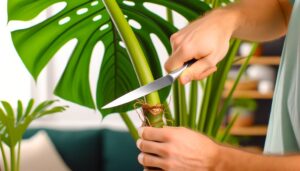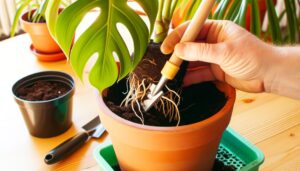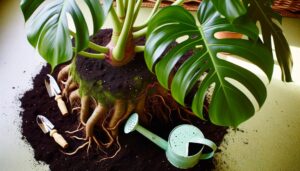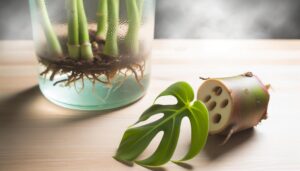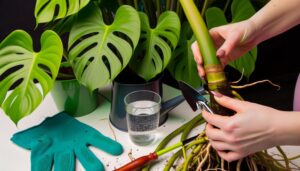Can You Propagate Monstera Without Node? Myth or Fact?
You can’t propagate a Monstera without a node because nodes are essential for new root and leaf development. Nodes contain meristematic tissue, which differentiates into roots and shoots.
This tissue houses the genetic material needed for growth. A cutting without a node lacks the necessary structure to sustain new growth.
Additionally, nodes often produce aerial roots, further aiding propagation. Properly identifying and including nodes in your cuttings maximizes success.
Cutting stems without nodes will lead to failed attempts. By understanding the role of nodes, you’ll see improved results in your propagation efforts.
To explore more techniques and tips, keep following.
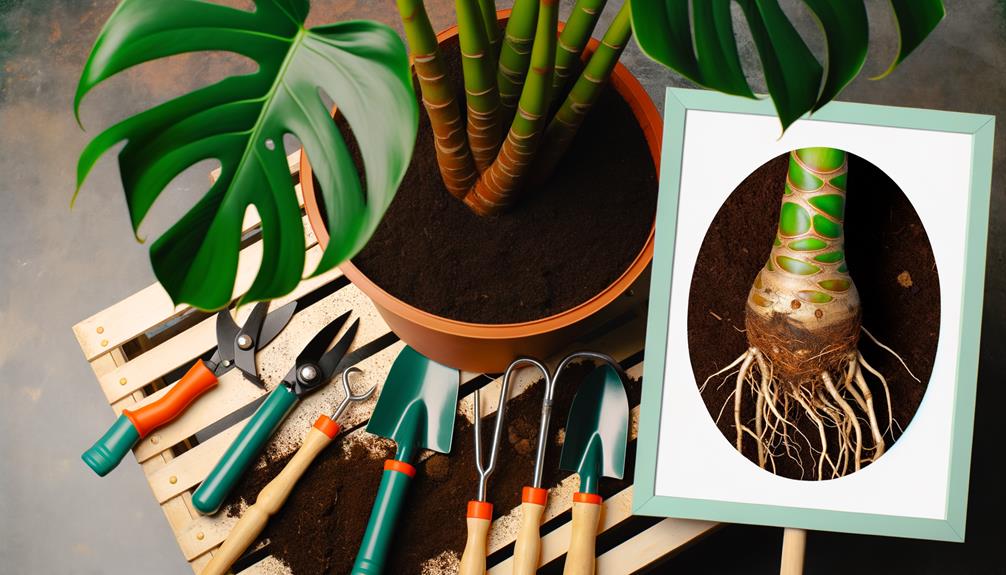
Key Takeaways
- Successful Monstera propagation requires at least one node.
- Nodes contain meristematic cells necessary for root and shoot growth.
- Cuttings without nodes lack the potential for new growth.
- Nodes are essential for the emergence of new roots and leaves.
- Propagating Monstera without nodes generally results in failure.
Understanding Monstera Nodes
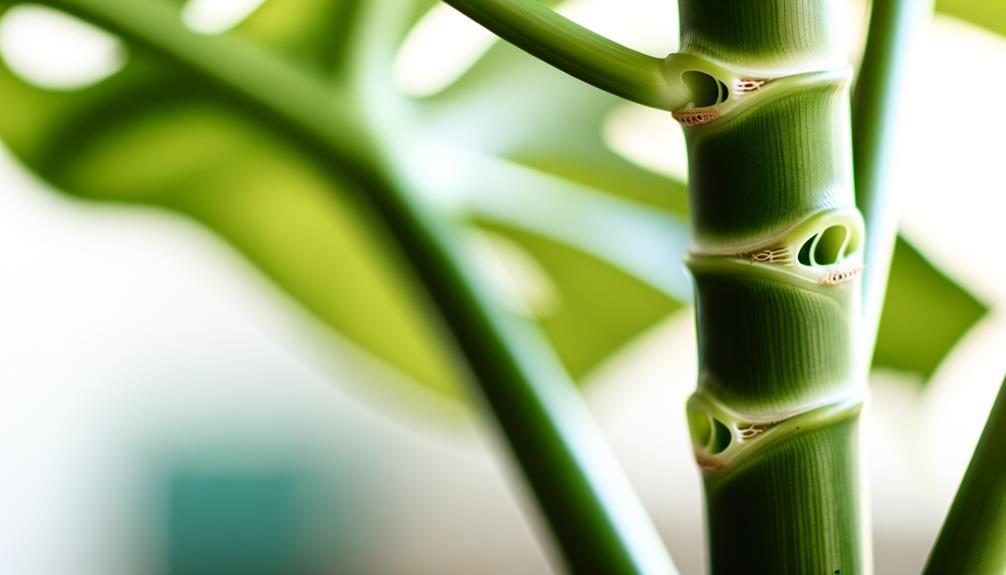
Monstera nodes are the pivotal points on the stem where new roots and leaves emerge, necessary for successful propagation. Located at intervals along the stem, nodes are identifiable by their thicker, knobby appearance.
Each node houses meristematic tissue, which is highly active in cell division. This tissue’s activity is essential for the development of new roots and shoots. You’ll notice aerial roots often protruding from these nodes, indicating their readiness to support new plant growth.
If you’re examining a Monstera, look for the leaf scars and small bumps these are your nodes. Understanding their role and structure is crucial because they’re the only parts of the stem capable of initiating new growth, ensuring your propagation efforts are fruitful.
The Role of Nodes in Propagation
You’ll find that nodes play a crucial role in Monstera propagation as they house the plant’s meristematic cells, which are essential for new growth.
When propagating, the presence of nodes plays a vital role in increasing the success rate since they contain the genetic material required for root and shoot development.
Without nodes, the cutting lacks the necessary cellular machinery to initiate and sustain new growth.
Node Function in Growth
Nodes play a crucial role in plant propagation, as they house the meristematic tissue responsible for new growth and root development. These meristematic cells are undifferentiated, allowing them to divide and specialize into either root cells or shoot cells, depending on the plant’s needs.
When propagating a Monstera, you’ll need a node because it’s the site where adventitious roots form. Without a node, the cutting lacks the cellular machinery necessary for root initiation, severely hindering its ability to establish.
Additionally, nodes contain axillary buds that can develop into new stems or leaves, further contributing to the plant’s growth. Hence, the presence of a node is crucial for successful propagation and subsequent plant health.
Propagation Success Factors
Understanding the critical role of nodes in propagation guarantees higher success rates when attempting to cultivate new Monstera plants. Nodes contain meristematic tissue, which is essential for root development and growth.
When you cut a Monstera stem for propagation, make sure it includes at least one node. This node’s meristematic cells will differentiate into roots and shoots, facilitating the establishment of a new plant. Without a node, the cutting lacks the necessary biological structures to generate new growth.
In addition, maintaining ideal conditions such as humidity, temperature, and light—ensures that the node can activate its growth potential effectively. By prioritizing the inclusion of nodes in your cuttings, you maximize the chances of successful Monstera propagation, leading to healthier, robust plants.
Identifying Nodes on Your Monstera
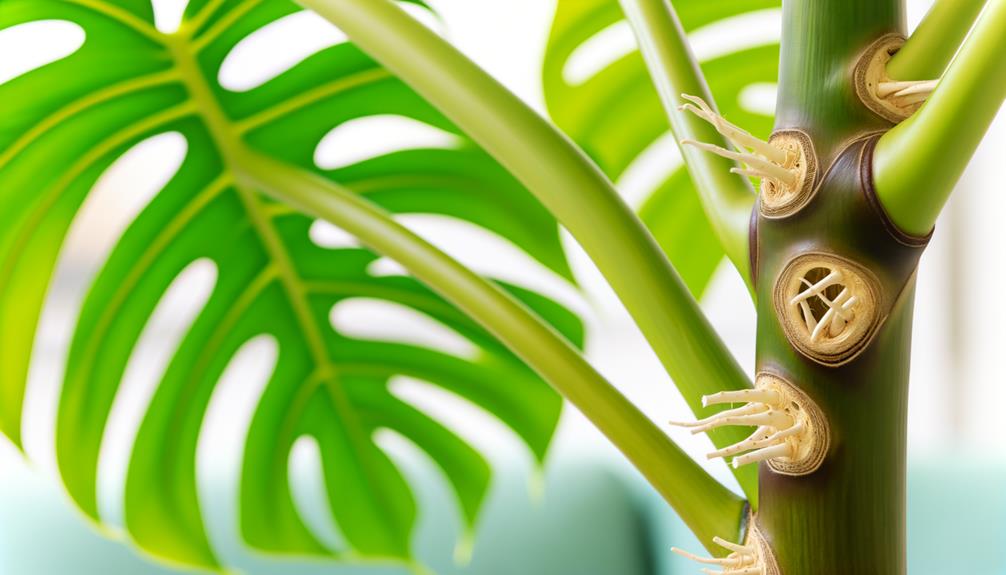
A node on a Monstera plant can be identified as the slightly swollen or knobby section along the stem, from which roots, leaves, or aerial roots emerge. You’ll recognize nodes by their distinct appearance and function. Examining your Monstera, you may find these nodes at intervals along the stem where new growth initiates.
Key characteristics to look for include:
- Swelling: Nodes are visibly thicker than the rest of the stem.
- Emergence Points: Locations where leaves or aerial roots sprout.
- Texture: Nodes often have a different texture compared to the smooth stem.
Understanding these characteristics will help you correctly identify nodes, essential for propagation success. Misidentifying them can lead to unsuccessful propagation attempts, so take your time to observe carefully.
Methods of Propagating Monstera
To effectively propagate Monstera, you need to understand stem cutting techniques, air layering steps, and water propagation tips.
Each method requires specific conditions and procedures to guarantee successful root development and plant health.
Let’s explore how you can utilize these techniques to propagate Monstera without nodes efficiently.
Stem Cutting Techniques
When propagating Monstera through stem cuttings, it’s important to make sure the selected segment includes at least one node, as this is where new roots and shoots will develop. Use sterilized pruning shears to make a clean cut just below the node.
Place the cutting in water or a well-draining soil mix to encourage root growth.
Ensure best conditions by:
- Maintaining humidity: Cover the cutting with a plastic bag to retain moisture.
- Providing indirect light: Place the cutting in a bright spot without direct sunlight.
- Monitoring temperature: Keep the environment warm, ideally between 20-25°C (68-77°F).
These steps maximize your chances of successful propagation by creating an ideal environment for root development and plant growth.
Air Layering Steps
Mastering air layering demands precision and attention to detail, as this propagation method involves promoting root growth while the plant remains attached to the parent.
Start by selecting a healthy stem with a visible node. Make a shallow cut just below the node, making sure you don’t sever the stem.
Apply rooting hormone to the cut to stimulate root development. Wrap the cut area with damp sphagnum moss, securing it with plastic wrap to retain moisture.
Guarantee the moss remains consistently moist, but not waterlogged. Over several weeks, roots will form within the moss.
Once a robust root system develops, sever the stem below the new roots and plant your new Monstera in soil.
Water Propagation Tips
While air layering offers a sophisticated approach to propagation, water propagation provides a straightforward method to cultivate new Monstera plants. Start by selecting a healthy cutting with at least one node, as nodes are essential for root development.
Place the cutting in a transparent container filled with room-temperature water, ensuring the node is submerged. Monitor water levels and replace the water weekly to prevent bacterial growth. You’ll observe root development within a few weeks.
To enhance success:
- Use distilled or filtered water to avoid chlorine and fluoride interference.
- Maintain indirect sunlight exposure to prevent algal growth and heat stress.
- Add rooting hormone to the water to stimulate faster root development.
This method leverages natural processes to achieve effective propagation with minimal effort.
Propagating Without Nodes: Myth or Reality?
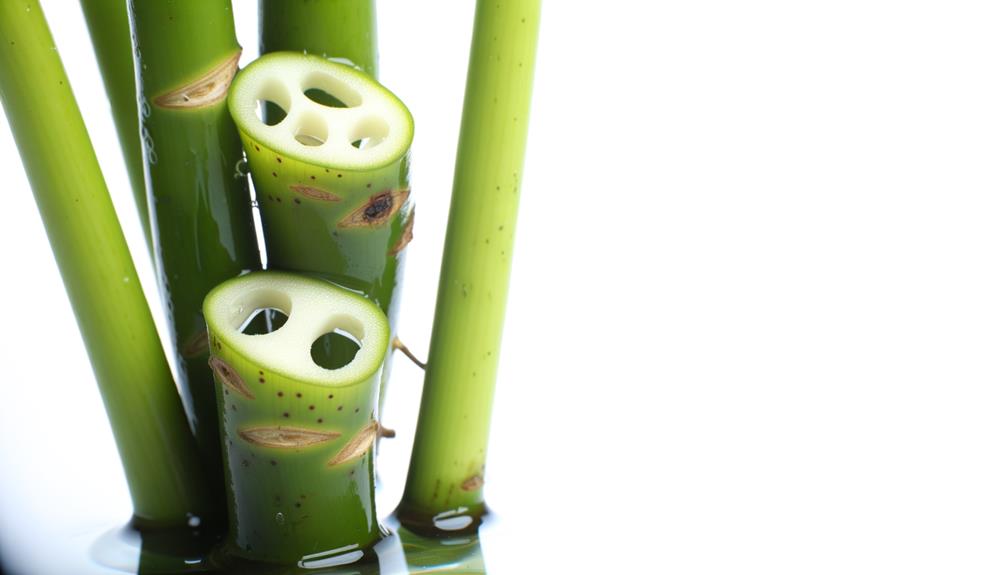
Propagating Monstera without nodes is often considered impossible because nodes contain the essential meristematic tissue required for root and shoot development. This tissue type is composed of undifferentiated cells capable of division and differentiation into various plant structures.
Without nodes, there’s no access to this meristematic tissue, vital for initiating new growth. Attempting to propagate from internodal sections, which lack these tissues, typically results in failure.
Internodal cuttings might survive temporarily but won’t develop roots or shoots, as they lack the cellular machinery needed for regeneration.
Scientific consensus supports this: successful propagation hinges on the presence of nodes. Therefore, while the concept of node-less propagation might intrigue, it remains scientifically unfeasible without innovative biotechnological interventions.
Success Stories and Anecdotes
Despite the scientific consensus on the necessity of nodes for successful Monstera propagation, numerous hobbyists have shared anecdotes that suggest otherwise. You’ll find stories of Monstera cuttings without nodes sprouting roots and thriving.
These accounts often include specific conditions that seemingly enhance root development, such as:
- Hydroponic setups: Utilizing nutrient-rich water solutions.
- Humidity chambers: Enclosing cuttings in high-humidity environments.
- Hormonal treatments: Applying rooting hormones to stimulate growth.
While these anecdotes may inspire you, it’s important to remember that they don’t align with the established botanical principles. The success rates of node-free propagations are inconsistent and typically lower than those involving nodes.
Hence, while experimenting, maintain realistic expectations and observe scientific guidelines for best results.
Common Mistakes to Avoid

Ignoring the necessity of nodes often leads to failed Monstera propagation attempts. You should understand that nodes are critical for root formation. Without them, the cutting can’t develop roots or new growth.
Avoid cutting stems without visible nodes, as they lack the meristematic tissue needed for root initiation. Misidentifying nodes is another common mistake. Recognize the swollen, knobby sections where leaves attach to the stem.
Additionally, inadequate humidity and light conditions can impede rooting. Monstera cuttings need a humid environment and indirect light to encourage root development.
Expert Tips for Better Results
To achieve best results in Monstera propagation, make sure your cutting includes at least one node, as this is essential for root and shoot development. Nodes contain meristematic cells that are crucial for generating new growth.
To optimize your propagation efforts:
- Sterilize Cutting Tools: Use isopropyl alcohol to prevent pathogen transmission.
- Optimal Environment: Maintain humidity levels around 70-80% and a temperature range of 65-75°F (18-24°C) for ideal growth conditions.
- Rooting Medium: Utilize a well-draining medium like perlite or sphagnum moss to provide aeration and moisture balance.
These steps guarantee that your Monstera cuttings have the best possible conditions to develop healthy roots and shoots, leading to successful propagation.
Alternative Propagation Techniques
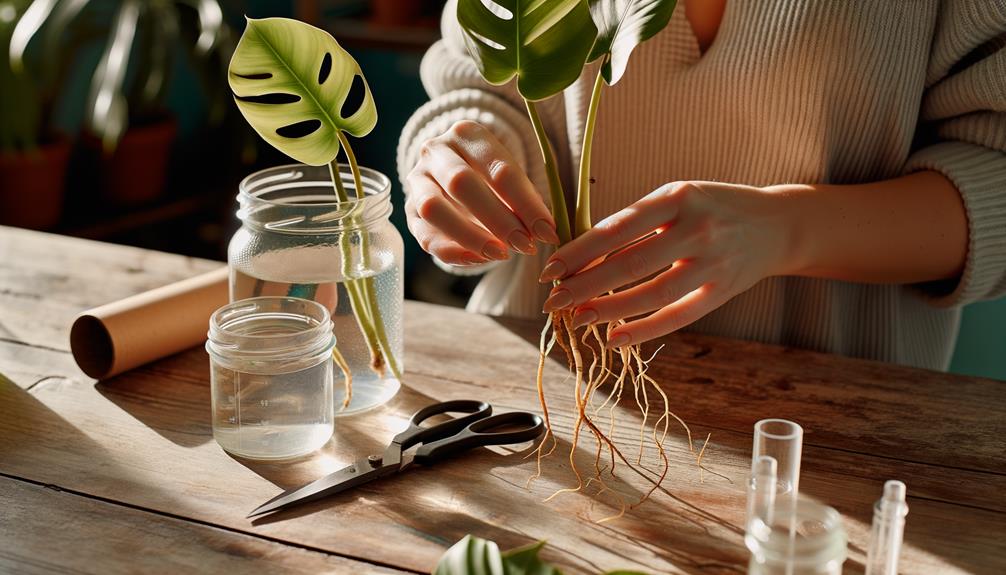
While traditional propagation methods rely on nodes, you can explore alternative techniques that focus on tissue culture, air layering, and leaf cuttings for propagating Monstera.
Tissue culture involves sterilizing plant tissues and cultivating them in a nutrient-rich, sterile medium to produce new plants. This method ensures genetic uniformity and rapid multiplication.
Air layering requires you to create a small wound on a stem, apply rooting hormone, and wrap it with moist sphagnum moss and plastic until roots develop.
Leaf cuttings, although less common, involve cutting a Monstera leaf and placing it in water or soil to promote root formation. Each technique requires precise conditions and care but offers viable options for Monstera propagation without depending on nodes.
Conclusion
To sum up, cultivating a cutting without a node is a common misconception. Nodes are essential for nurturing new growth. Neglecting nodes will nullify your propagation prospects.
Remember, roots radiate from nodes, and without them, your cutting won’t sustain. Stick to scientific strategies and make sure nodes are noticeable before you start.
Apply these accurate approaches and avoid amateur errors, guaranteeing your Monsteras multiply magnificently. For the best botanical outcomes, always prioritize proper propagation practices.

